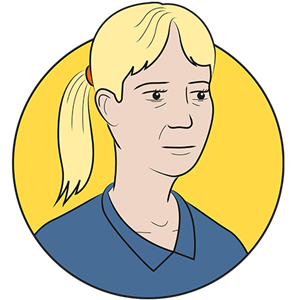 Jo is 35 and lives in a regional town.
Jo is 35 and lives in a regional town.
Jo left an abusive relationship. The local women’s refuge had no room and she has been using all her connections to find somewhere to stay. While she waits for emergency housing, Jo is sleeping on friends’ couches while her kids are placed with foster families.
Jo’s goal is to have a house where she and the kids are safe. She’s doing her best to save a bond at her minimum wage job because she doesn’t know when the public housing system will come through for her.
"Being homeless has kicked the ground out from under me. Everything is unstable. It makes everything harder — working, keeping in touch with my kids, saving money for our new place. My friends are so kind to let me stay but they have a big whānau. They need the extra space."
— Jo on homelessness
Nearly 1% of our population is homeless
The number of people experiencing severe housing deprivation is conservatively estimated at 41,644 people — approximately 0.9% of the population. Compared with previous 2013 Census data analysis, it's estimated that severe housing
deprivation has increased by 0.7% per 10,000 population — an increase of around 4400 people. This means that many
people in Aotearoa NZ are struggling to find safe housing and don't have a home to call their own.
Our emergency housing system places whānau in desperate need of permanent housing in motels, only intended for short-term stays, until more permanent accommodation could be arranged. The current system doesn't meet the Government’s
own definition of homelessness of 'rare, brief and non-recurring'. Emergency Housing Special Needs Grants are intended to
cover 7 days’ accommodation. The average emergency housing stay in a motel is 7 weeks.
Reducing the reliance on motels as emergency accommodation must be a priority. Motels are only a stop-gap. The emphasis must be on providing safe, warm, dry and affordable homes for whānau. The reliance on motels to support our most vulnerable whānau is indicative of the scale of the issue. As a UN Special Rapporteur said in February 2020, it has moved from a housing crisis to a human rights crisis.
 Anna is 25 and was made redundant due to the COVID-19 pandemic.
Anna is 25 and was made redundant due to the COVID-19 pandemic.
Living in the city, housing costs are high. While Anna lives with 3 flatmates, her rent and bills takes up most of her income from her COVID-19 Income Relief Payments, which
will end in September.
Anna’s marketing job gave her a good income and she was enjoying living in the inner city with many food and entertainment options. She had no savings and hasn’t been able to find a new job despite applying for dozens since her redundancy.
She’s worried they will be evicted if they miss rent payments, especially once they received notice that the landlord was increasing the rent by $40 a week once the COVID-19 Rent Freeze ends.
"My anxiety is in overdrive right now. If I can’t find a job before my Income Relief payments run out, I have to go on Jobseeker Support and move out of my flat. We just got a letter to say the rent is going up too."
— Anna on the costs of housing
Aotearoa NZ needs a fair tenancy system
One in three New Zealanders are renters in the private rental market, yet our housing system favours home
ownership as the only desirable option. This is despite the most ‘affordable’ homes being priced many times the average income.
Some cosmetic changes have been made to the Residential Tenancies Act 1986. Our rental system remains stuck in the 1980s, resulting in a lightly-regulated, market-driven industry. Tenants have few options other than the Tenancy Tribunal. Many tenants are unaware of their rights as renters, or of the Tribunal’s functions.
The imbalance of power is starkly illustrated through Tribunal application data, where 90% of applications arise from
property owners, effectively rendering it a Landlords’ Tribunal. The Tribunal is also funded by interest generated from tenancy bonds lodged by the property owner or manager. This means that tenants’ funds are being used to support a system that landlords derive the most benefit from.
Non-government organisations, including Community Law, the Citizen’s Advice Bureau and small Tenants’ Associations, provide the majority of advocacy and report high demand for their services. For tenants in smaller towns, there are even fewer services available. Regardless of location, reports show tenants throughout Aotearoa NZ are reluctant to take a case to the Tenancy Tribunal. They fear retaliation and retribution, including being evicted. There needs to be systemic change through long-term reorientation of the rental market and the modernisation of the Residential Tenancies Act. A comprehensive national tenancy advocacy service that is free to access must be an urgent priority for housing reform.